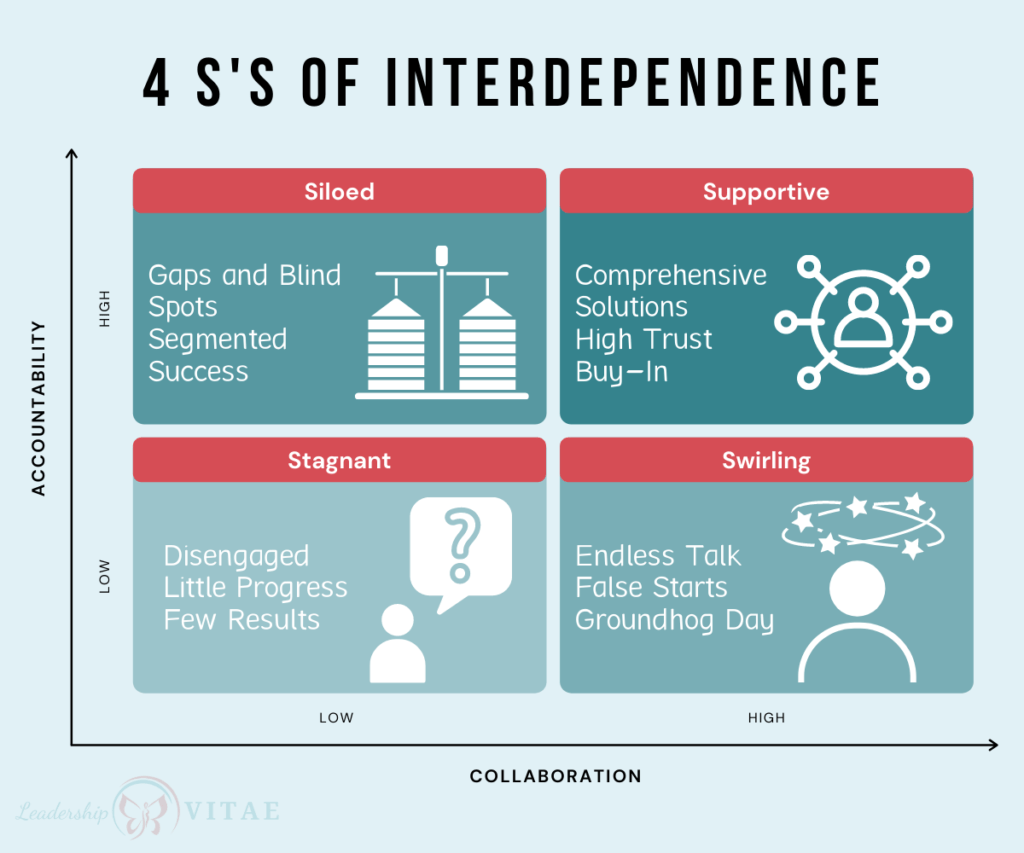
Individual success has been celebrated, if not revered, for most of US history. There are endless “how to’s” on achieving individual success.
Yet independent achievement is a myth.
Our institutions often reinforce this myth. Whether it’s our grades in school, or performance reviews at work, the individual is frequently the focus.
If we learned nothing else from 2020, it’s how illusory the idea of individual independence is. And how interdependent we all really are.
There are entire systems, and groups of people, that shore up each individual. They either contribute to, or potentially erode, opportunities for forward movement and success. It may be our family members, teachers, community leaders, coworkers…the list goes on.
Yet we perpetuate the myth of individual achievement as this lone act.
Interdependence, in our households, communities, and businesses, is critical to successful outcomes. While interdependence is critical, its health makes all the difference.
Accountability alone is not enough
When I first arrived at a new company, I asked what I was accountable for. Historically, I knew my area of focus and that of my team. Areas where I could make decisions, vs those where others “had the ball” so to speak.
“We don’t talk like that here. We collaborate”. I was taken aback by the feedback I received. Accountability and collaboration are not mutually exclusive.
Instead, accountability makes it clear where ownership lies for making decisions and affecting outcomes. Collaboration determines whether those decisions and outcomes are supported and successful.
No one – no team – is an island.
Someone having accountability for decision-making is not enough. Not if it means no one is willing act upon the decision. This is where collaboration comes in.
One person or group may be accountable, and only one should be. However, there’s a reason why RACI charts exist. A RACI captures who makes decisions, and who is engaged.
The case for engaging others
When we’re accountable for an outcome, or looking to a group or leader to make a decision, it can feel like slow going sometimes. Collaboration and engagement takes intention. It may be perceived as bureaucracy or red tape.
Engaging others may slow things down. Yet collaboration is key to achieving successful outcomes.
- Gain different perspectives. If one group or person has an idea, and only checks in with their same group for feedback, it can be an echo chamber. Getting outside perspectives helps to fill in gaps and identify blind spots. Done right, diverse views get to improved decisions.
- Obtain buy-in. As mentioned before, just because a person or group has accountability doesn’t mean they can do everything on their own. Decisions often require others to implement, support, or accept an outcome. Those same stakeholders may reject decisions without engagement.
- Share responsibility. While there should only be one point of accountability, responsibility is often shared. Those contributing to the eventual outcome are more likely to help it be successful if they have a chance to influence it.
Interdependence
Interdependence is the intersection of accountability and collaboration.
It is a tricky balance. Too much of one, or not enough of another, creates unhealthy conditions that limit successful outcomes.
We are interdependent as a species and global economy. It shows up in organizations, teams, and families. There may be a face to success, but that success comes with the help of others. If we succeed, but those around us fail? We still fail.
So what does interdependence look like in teams? When is it healthy and when does it create havoc in organizations?
When we look at team outcomes, we can determine whether there is too much or not enough collaboration and accountability in the mix.
Four S’s of interdependence
Accountability and collaboration occur on a spectrum. For the sake of simplicity, we’ll consider high and low levels of each in a team or organization.
Rarely are things that simple, but if we evaluate the behaviors of a team, we can back into which of the two (or both) may need adjustment.

Stagnant
Teams with low accountability and low collaboration are getting nothing done. Everyone is heads-down and focused on assigned work. These tend to be groups of order takers, demonstrating limited initiative or progress towards organizational goals.
Swirling
Walking into a swirling team feels like groundhog day. Conversations occur again and again without resolution or progress. In these teams, everyone wants to be heard and have a vote without owning the outcome. Even if someone wants to make decisions, others may assume veto power. In the swirl, there is a lot of engagement with a resistance to decision-making and action. At it’s worst, it can feel like a codependent relationship.
Siloed
Silos can get a lot done in their area of accountability. Leaders and teams make decisions quickly and prioritize execution. Potentially leaving others behind or creating missed opportunities. Clear delineations of accountability make decision-making and progress easy, but lack of collaboration can result in gaps and blind spots.
Supportive
The holy grail of teamwork in healthy organizations is a balance of accountability and collaboration. Advocates and challengers can offer their views to help create better outcomes. Teams and leaders consider and integrate ideas and concerns. They make influenced and accepted decisions.
Healthy interdependence is a leader’s goal
The ultimate goal of any leader should be to have healthy engagement fueling successful results. Interdependence that lifts the organization, instead of holding it back.
I have been part of organizations in all four quadrants of interdependence.
The military had very clear accountability and top-down decision-making, resulting in a highly siloed environment. I’ve come into teams that were stagnant and established clear lines of accountability. Modeling engagement and collaboration helped move towards a healthier culture.
I’ve spent a lot of time pondering the swirling culture I’ve more recently experienced. This is new for me, and my focus has been on what I can do differently to help my team get from the swirl to supportive progress.
The first step in moving from unhealthy to healthy is to name what is happening and why. In the coming weeks and months, we will be putting new practices into place. I will share our insights and tools to help others caught in the swirl.
Have you found yourself or your team in unhealthy interdependence? What suggestions do you have for moving to supportive interactions, with high accountability and collaboration? I’d love if you would share your thoughts in the comments.








